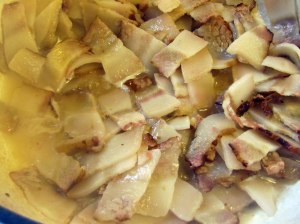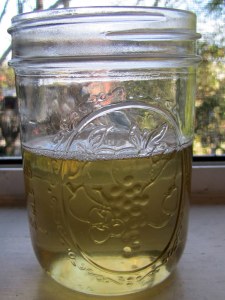I have been searching for a pig jowl for over a year now. I have dreams of making guanciale. I’ve asked at butcher counters, farmers markets and friends who said they were buying in on a pig and I’ve come up empty on every front. That was until recently when Beth, from Dandelion Spring Farm, came through for me. She had jowl, she said, but it was sliced like bacon. Fine enough for me as I was happy to get the raw product. Pig jowl is very similar to an uberfatty pork belly, with streaks of meat almost like an after thought cutting through the stark white fat. I thought that maybe I could still work with it, cure it some how, until a friend told me that it wouldn’t work. So, what to do with nearly a pound of pig fat, I pondered.
Lard, I thought. Pure, beautiful, crust enhancing lard. Make it now and use it to make a pie crust when the Missus’ family comes up for Thanksgiving. Genius.
I didn’t realize, though I should have asked, that when she said it was sliced like bacon, that it was also smoked. Mistake on my part. It wasn’t, however, going to stop me from spending an hour or so after work tending to the task over my dutch oven. The only thing that would change would be what I eventually use the lard for. Now it gives me two months to figure out a plan for that. But, they’re Lithuanian, so anything pork based and fatty, is fine enough for them.
The crackling, which was munched on while the lard cooled, reminded me of the skin of some of the best fried chicken I’ve had in my life–which, of course, had been cooked in lard. It was easy, hardly time consuming and now I have a pint of liquid gold and some time to think of a really good use for it.
How to Render Lard–from The Homesick Texan.
What you need:
A pound or so of pig fat, either leaf lard or fat back. Leaf lard is the best grade of lard and is preferred for pastry, while fat back is the next-best grade of lard and is appropriate for frying. Each pound of fat will yield about a pint of lard.
A big pot
A lard stick (though a wooden spoon will suffice)
Some water
Some containers—Mason jars work nicely.
What to do:
1. Open your kitchen window.
2. After buying your fat, preferably from a farmer or butcher that treats its hogs humanely, chop it up into little pieces.
3. In a Dutch oven or heavy, large pot, add about a half of a cup of water to the pot, and then add the cubed fat.
4. On the stove, heat the pot on medium low, stirring occasionally (every 10 minutes).
5. After the fat starts melting (about an hour), you’ll hear some very loud pops. Do not be alarmed—that is just the last gasp of air and moisture leaving what will soon become cracklings (little fried pieces of pork). Now is the time to start stirring more often.
6. Soon after, the cracklings will start floating on the surface. Keep stirring frequently, but be careful—you don’t want the fat popping out of the pot and burning you.
7. When the cracklings sink to the bottom, the lard has been rendered.
8. Let it cool, and then pour it into containers through a colander or strainer lined with cheesecloth. The cracklings will be left behind in the cheesecloth and these make for a fine, fine snack, especially sprinkled over salad if that’s not too perverse for you.
9. The lard will be a yellowish liquid. This is what it’s supposed to look like.
10. Refrigerate it overnight and when it solidifies it will turn white. It will keep in the refrigerator for about three months, and the freezer for up to a year.





